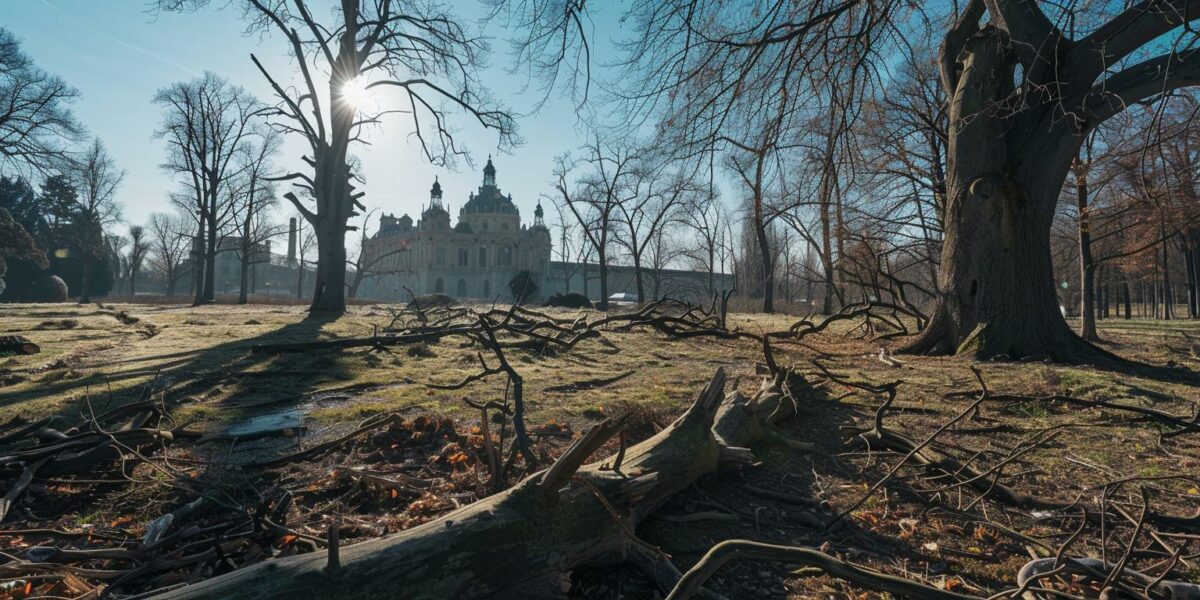Unseen Struggles of Sanssouci Park’s Trees
Sanssouci Park in Potsdam, a UNESCO world heritage site, still impresses visitors with its majestic avenues and monuments. However, a closer look reveals disturbing signs of distress among its trees. Beech trees with thinning crowns, fallen branches, and peeling bark are all indicators of the climate crisis impacting this historic landscape.
According to Sven Kerschek, a former chief gardener, the park’s trees have been experiencing a dramatic decline in health since 2017. The extreme summer of 2018, with its unrelenting heat and drought, marked a significant turning point. Even recent wetter summers have failed to reverse the damage.
Climate change is a multifaceted issue. Kerschek explains that even well-watered trees are suffering from other factors like constant harsh sunlight, low atmospheric humidity, and increased fungal infections. Invasive insect species, previously unseen in the area, are also contributing to the trees’ decline.
Tree loss in Sanssouci Park has been alarming. Between 2002 and 2015, the park lost 18 to 87 trees annually. Since then, the number has consistently exceeded 100, peaking at 315 in 2020. This decline has prompted the Prussian Palaces and Gardens Foundation to take action.
Re:Generation – An Exhibition of Hope and Awareness
This summer, the foundation is hosting an open-air exhibition titled “Re:Generation” to shed light on the park’s struggle with climate change. Visitors can witness firsthand the challenges the trees face and the efforts being made to combat these issues.
The exhibition aims to raise awareness about the visible impacts of climate change, not just in places prone to floods but also in idyllic locations like Sanssouci Park. Curator Katrin Schröder hopes it will highlight the urgent need for action to preserve these historic trees.
Visitors will see trees suffering from “sunburn,” with dried and peeling bark, making them vulnerable to fungi and animals. They will also observe how ground water levels have drastically receded in recent years, affecting older trees significantly. However, there are also stories of resilience, with some trees defying the odds and thriving.
To enhance the park’s resilience, the foundation is considering several approaches:
- Collecting seeds from robust older trees to grow young trees in controlled conditions.
- Exploring tree varieties from southeastern Europe that can withstand hot summers and late frosts.
- Avoiding the introduction of exotic species to maintain the park’s historic character.
Hope for the Future
The park’s oldest trees, some as old as 300 years, offer a glimmer of hope. These trees have survived various climate conditions over the centuries and may possess the genetic resilience needed to adapt to current challenges. Kerschek and his team aim to harness this resilience by planting seeds from these hardy trees.
Sanssouci Palace, the summer residence of Prussian King Frederick II, is surrounded by this vast park, which spans nearly 300 hectares. Despite the challenges, the park’s dedicated team of nearly 60 gardeners is committed to preserving its historic charm and natural beauty.
While replacing native tree species with exotic ones is not an option, the team is exploring the potential of using varieties of linden trees, oaks, and beeches from regions with similar climates. This approach could help the park’s trees better withstand the changing conditions without altering its historical landscape.
Schröder emphasizes that the goal is to preserve the park’s character. “We don’t want to change the park in such a way that it has a completely changed mixture of trees,” she says. The foundation’s efforts are aimed at finding solutions that respect the park’s heritage while ensuring its survival for future generations.
A Call to Action
The situation at Sanssouci Park is a stark reminder of the broader impacts of climate change on our natural and cultural heritage. It highlights the need for immediate and sustained action to address these challenges. The park’s story serves as a powerful call to protect and preserve our environment.
As visitors walk through Sanssouci Park, they are not just witnessing history; they are also seeing the effects of a rapidly changing climate. The park’s resilience and the dedication of its caretakers offer hope, but the road ahead is challenging.
The open-air exhibition “Re:Generation” is a step towards raising awareness and inspiring action. It reminds us that the fight against climate change is not just about preserving landscapes but also about safeguarding our cultural heritage.
Ultimately, the story of Sanssouci Park is a call to all of us to take responsibility for our planet. By understanding the challenges and supporting conservation efforts, we can ensure that this historic park and others like it continue to thrive for generations to come.



noraelysium
Interesting read, but why did it take so long for authorities to act? 🤔
julian7
The open-air exhibition sounds fascinating. I’ll definitely check it out!
Silas
Is there any hope for reversing the damage already done to the trees?
leahflux
Great article! How can visitors contribute to the preservation efforts?
jasmine7
Why isn’t more being done to combat this problem? It feels like we’re always reacting instead of preventing.
CocoOasis
Wait, trees can get sunburned? That’s wild! 🌞
Adam
So sad to hear about the tree crisis. Thanks for highlighting this issue. 🙏
LunaIllusion
Do you think planting more resilient tree species will really help in the long run?
adrian
It’s heartbreaking to see such a historic place suffer. 😢
josiah
Wow, I had no idea climate change was affecting Sanssouci Park so badly! Are there any specific actions we can take to help?